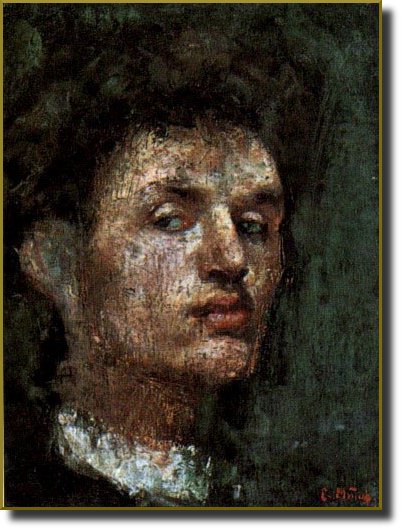Description
The work "Self -portrait" of Edvard Munch, painted in 1886, is a notable example of the deep introspective approach that characterizes the work of the Norwegian artist. In this work, Munch presents himself with a penetrating look that invites the viewer to reflect on the complexity of identity and the human psyche. Self -portrait is a genre that has been explored by numerous artists throughout history, but Munch's unique vision is distinguished by his ability to intertwine the personal with the universal.
In the composition, Munch chooses a colored palette that fluctuates between terrible and gloomy tones, using the green and brown that evoke a feeling of melancholy predominantly. The background, an intense green, seems to darken in the upper part, suggesting an oppressive atmosphere that contrasts with the author's figure, whose face is presented in lighter tones. This chromatic choice not only provides a sense of depth and three -dimensionality to the figure, but also reinforces the emotional connection that the viewer establishes with the self -portrait. The light that affects Munch's face highlights the characteristics of his expression, which is both restless and introspective.
The layout of his figure is almost outlined, suggesting a simplicity that contrasts with the complexity of his internal feelings. Munch opts for an expressionist approach, where emotion manifests itself through physical appearance; His disturbing, almost direct look, captures a state of vulnerability and restlessness, reflecting a constant tension between the individual and his environment. This use of color and shape is representative of Munch's style, which often explores issues of anxiety, love, death and the human condition, manifesting its own existential struggle.
It is interesting to note that during the period in which Munch made this self -portrait, his personal life was flooded with emotional confrontations and family traumas. This biographical context is essential to understand the emotional burden that emanates from painting. Munch uses self -portrait as a way to examine his own identity, a practice that will repeat in various works throughout his career.
Compared to contemporary works, the "self -portrait" of 1886 shares similarities with the portrait of Vincent van Gogh, who also used self -portrait as a form of personal exploration. However, while Van Gogh tends to instill his work with vibrant colors and bold textures, Munch chooses a more controlled and off palette, perhaps reflecting an even deeper and more gloomy sense of introspection.
Although this specific work may not be as well known as "the cry", its relevance in the context of the development of expressionism and its ability to convey existential anguish deserve attention. "Self -portrait" of 1886 encapsulates the essence of the internal struggle of Edvard Munch, an artist whose work has influenced generations of creators, leaving an indelible mark on the panorama of modern art. His ability to capture the complexities of the human condition continues to resonate, reminding us that art is, in its purest nucleus, a reflection of the soul of the artist himself.
KUADROS ©, a famous paint on your wall.
Hand-made oil painting reproductions, with the quality of professional artists and the distinctive seal of KUADROS ©.
Art reproduction service with satisfaction guarantee. If you are not completely satisfied with the replica of your painting, we refund your money 100%.

